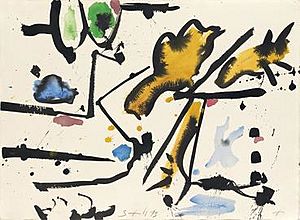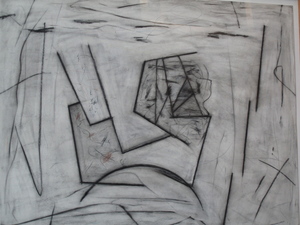Carroll Sockwell facts for kids
Quick facts for kids
Carroll Sockwell
|
|
|---|---|
| Born | February 13, 1943 Washington, D.C., U.S.
|
| Died | July 9, 1992 (aged 49) Washington, D.C., U.S.
|
| Nationality | American |
| Education | Corcoran School of Art |
| Occupation | artist |
| Known for | painting, drawings, sculptures |
Carroll Sockwell (1943–1992) was an American artist. He created drawings, paintings, and sculptures. His art was nonrepresentational, meaning it didn't show real objects or people. Instead, he combined different styles. He used both clear, geometric shapes and free, flowing lines.
Carroll Sockwell was known for adding subtle colors and details. He did this even in his simple art themes. His work was unique and hard to describe. People saw it as both strong and gentle, serious and playful. He faced many challenges in his life. Yet, he was very dedicated to his art. He believed being an artist was enough.
Contents
Early Life and Art Education
Carroll Sockwell was born on February 13, 1943. He grew up in Washington, D.C. His grandmother raised him. His mother worked as a maid. His father sometimes worked as a laborer or served in the military. He lived with many family members.
When he was young, his mother faced health challenges. She spent time in a hospital. Later, Carroll also spent time in a hospital for his own health. While there, he became interested in music, theater, and painting.
In 1957, at age 14, he began studying art. He attended the Corcoran School of Art. The next year, he won an award for his art.
At the hospital, he met Elinor Ulman. She was an art therapist. She became his guide and friend. She showed him art galleries and museums in D.C. She also encouraged his dream of becoming an artist.
In 1959, at age 17, Carroll moved to Manhattan. He worked at a store called Bonwit Teller. He also met famous abstract expressionist artists. He visited places like the Cedar Bar where they gathered. He found it hard to get started in the New York art world. He felt it was difficult for him to be accepted as a Black artist. So, he returned to Washington D.C. in 1963.
Back in D.C., he worked odd jobs. In 1965, he became a curator. He worked for three years at the Barnett-Aden Gallery. This was a non-profit African-American art gallery. Around this time, he met important people. These included Walter Hopps, James Harithas, and Harry Lunn. They helped support his art career.
Art Career and Exhibitions
In 1958, when he was 15, Carroll won a prize. It was for his painting called "Bridge With the Sun." In 1966, his art was shown in New York City. Two years later, his work was part of a show. It was at the Corcoran Gallery in D.C. This show featured "hard-edge" art.
The next year, his art was in another group show. This one was sponsored by the NAACP. Other artists in this show included Norman Lewis and Alma W. Thomas. His work also appeared in other galleries. These included the Ringling Museum in Florida.
In 1971, Carroll had his own show. It was at the Jefferson Place Gallery. The show was called "Mirror Compositions." Critics liked his work. Both the Washington Post and Jet magazine wrote good reviews. He had another solo show at the Corcoran in 1974. That same year, his art was shown at the Whitney and Brooklyn Museums. He also created a large mural. It was 40 feet long. He made it for a hospital in D.C.
Carroll continued to show his art. He exhibited in Washington galleries. These included Middendorf, Fraser, and Fiedler.
Towards the end of his life, he faced challenges. He sometimes found it hard to work. He passed away on July 9, 1992.
Just before he died, a solo show of his work opened. It was at the Washington Project for the Arts. Critics praised his art. One said it was "one of its worthiest and most compelling shows." People in the art world admired his talent. But they also knew he focused on creating art. He didn't focus on the business side of it. One friend said, "Carroll thinks being an artist is enough." Another said he painted because he had to, "like a raw nerve."
After his death, his art continued to be shown. In 1999, a special show of his work took place. It was at Case Western Reserve University. His friend and mentor, James Hilleary, helped organize it.
Art Style and Influences
Carroll Sockwell's art was nonrepresentational. It combined geometric and gestural styles. Critics saw a balance in his work. It was both strong and free. One person said he found a balance between "wild" and "tame" elements. A colleague noted his ability to combine opposite ideas. He would then show them visually in his art.
Many critics believed his life experiences influenced his art. They found his style hard to put into one category. One critic called it a unique mix. It combined "classical modernism and minimalism." A friend described his art as "classicism in despair."
Sockwell mostly worked on paper. He used materials like graphite, charcoal, and pastels. He also used watercolor, gouache, and acrylic paints. Many of his works feature grays, blacks, and whites. Most of his art was two-dimensional. But he also made some mixed-media wall sculptures. He created both large and small pieces.
The untitled work from about 1965, shown above left, uses gouache. It features grays and blacks on paper. The untitled work from 1973, above right, uses watercolor and acrylic. It has many colors on paper. The untitled work from 1988, below left, uses India ink. It also has subtle colored pencil on paper. The work called "Legend 3," below right, uses mixed media on paper.
A critic named Michael Welzenbach reviewed Sockwell's art. He said it was about creating beauty and movement. He described it as a series of connected musical ideas. They revolved around a steady rhythm.
Personal Life
The Sockwell family lived in a house in Foggy Bottom. This area is now where the Watergate Hotel stands. His maternal grandmother, Sarah Wilson, lived there. His aunt, Edna Johnson, and her husband, Lonnie Johnson, also lived with them.
Carroll's parents were Luther and Annie Sockwell. He had four older brothers: Edward, Paul, Luther, and Eugene. His mother was born around 1912. His father was born around 1903. Before Carroll was born, the women in the family worked as housekeepers. Lonnie was a dishwasher. Luther worked in a cemetery.
Carroll's mother faced health challenges. She spent time in St. Elizabeths Hospital. His aunt, Edna Johnson, helped care for him and his brothers. Carroll himself was a patient at St. Elizabeths at different times. He also spent time in the psychiatric ward of D.C. General Hospital. He was an African-American artist.





